| DESCRIPTIONS | INTRODUCTION & HISTORY |
Please Click On Any Picture for a Larger Version
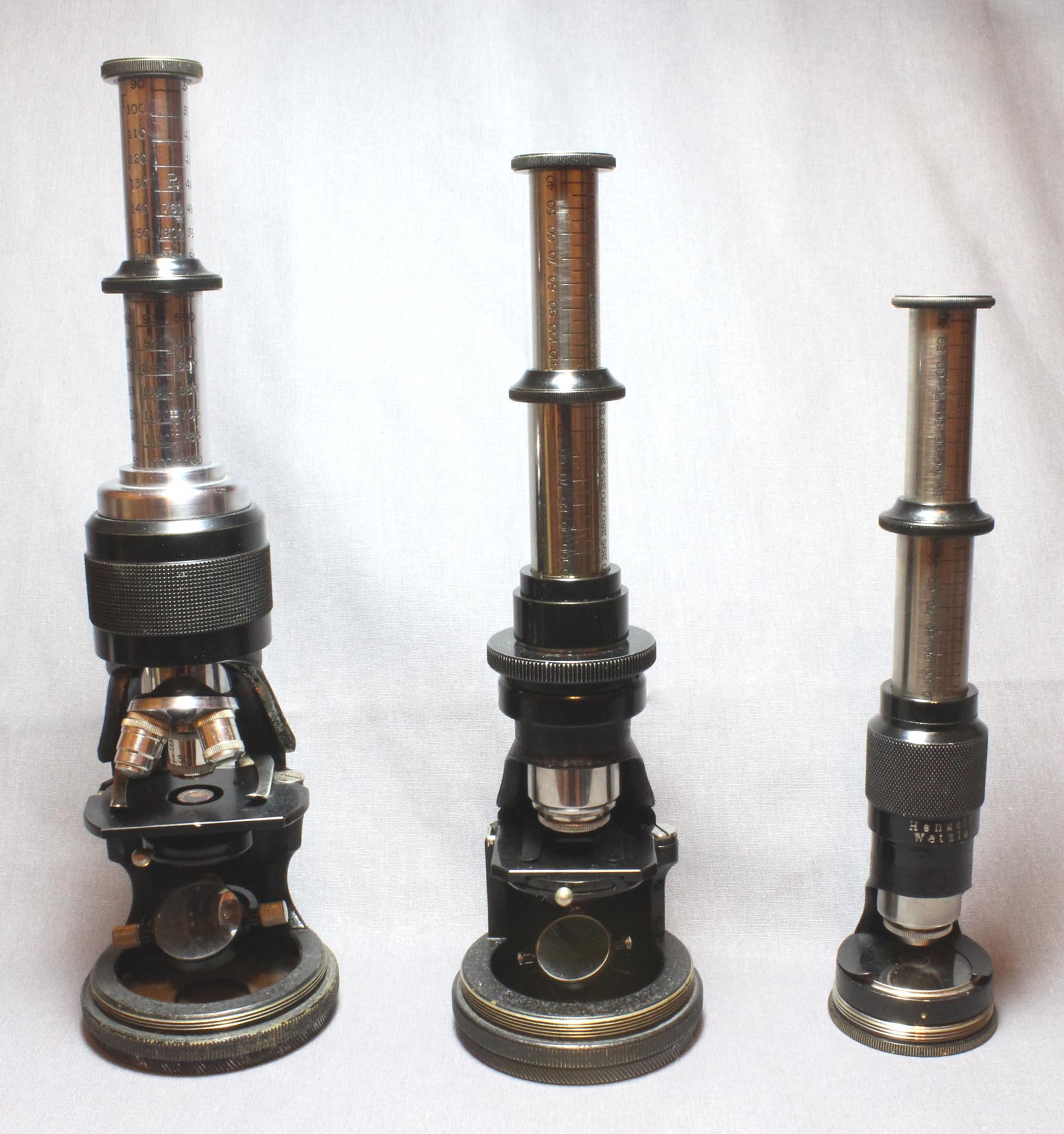
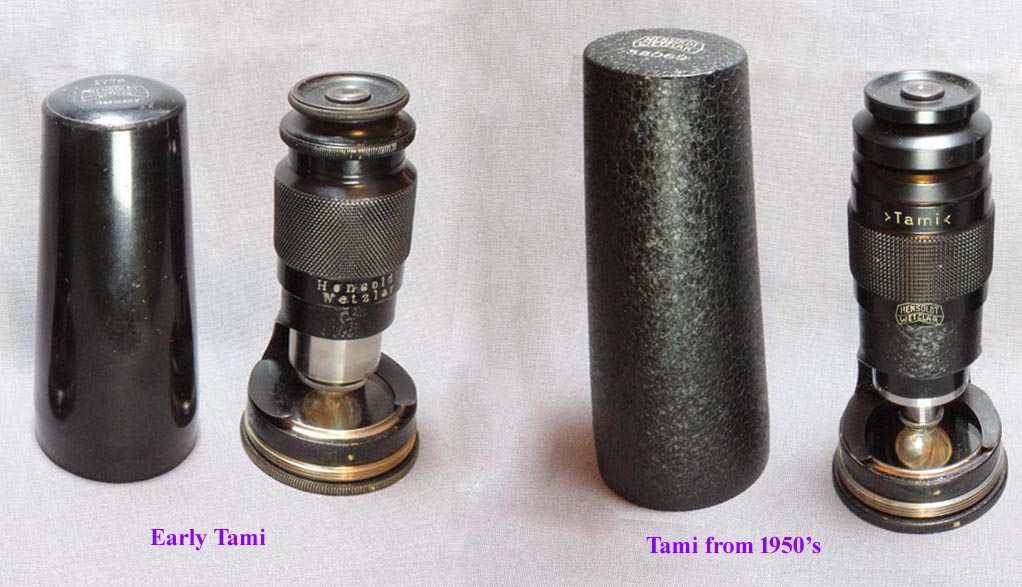
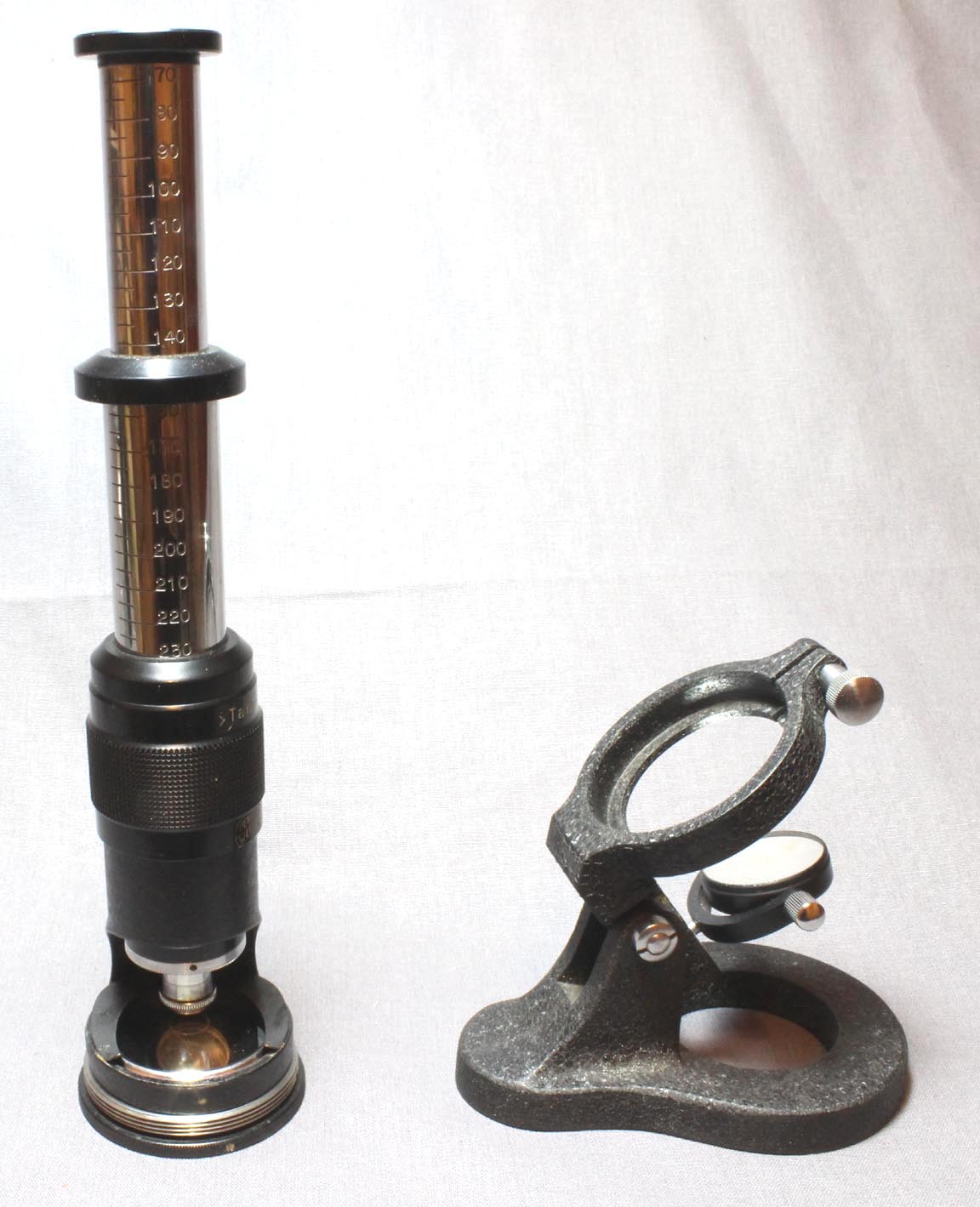
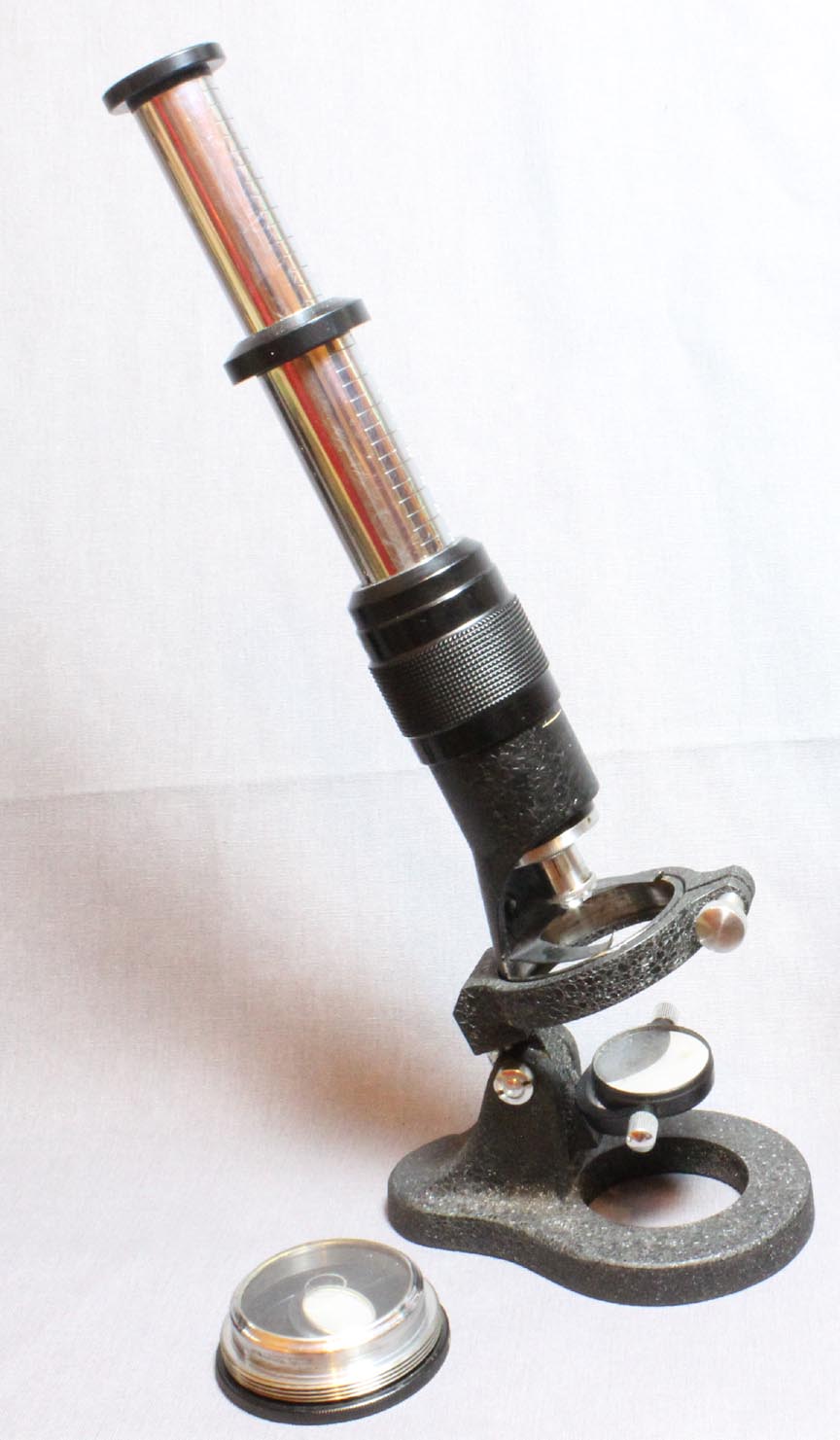
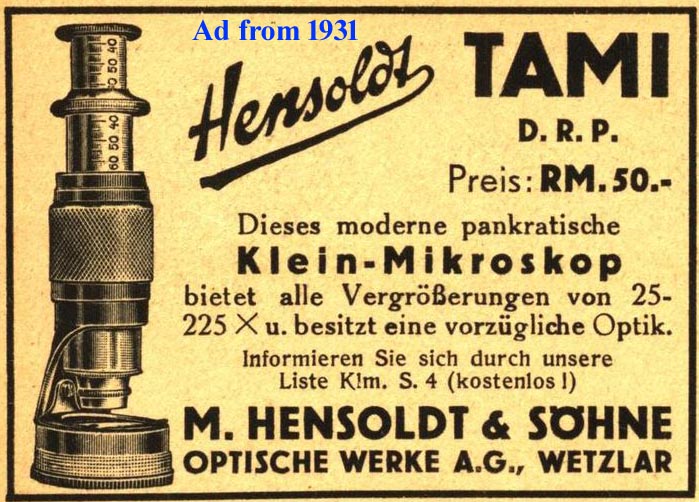 The concept of a 'pocket microscope' dates back to the 18th century. Although this idea persisted more or less through the years that followed, a period of greater interest in pocket instruments, particularly modern achromatic ones, started with the introduction of the Hensoldt Tami in the early 1920's. These microscopes by Hensoldt of Wetzlar, Germany are rugged and highly portable instruments. Hensholdt became a division of Zeiss as early as 1928 and they continued production into the third quarter of the 20th century.
The concept of a 'pocket microscope' dates back to the 18th century. Although this idea persisted more or less through the years that followed, a period of greater interest in pocket instruments, particularly modern achromatic ones, started with the introduction of the Hensoldt Tami in the early 1920's. These microscopes by Hensoldt of Wetzlar, Germany are rugged and highly portable instruments. Hensholdt became a division of Zeiss as early as 1928 and they continued production into the third quarter of the 20th century. tilting standwas an extra $16 in 1956, or about $160 extra today. Note that the cost of the Metami was a lot more than the Tami for only a modest degree of improvement; it cost 2/3 of the cost of the Protami. This is likely the reason they were not very popular and were made for a relatively short time. Details of the history of Hensoldt are found on my Hensoldt history page.
THE EARLY TAMI MODEL
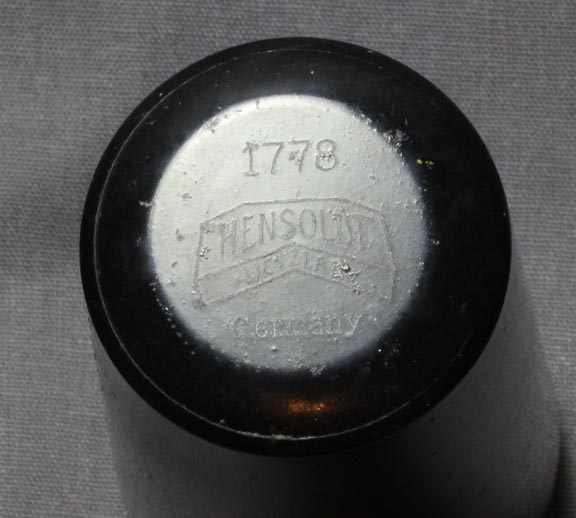 The microscope has a smooth semigloss black and chrome (or nickel) finish. It has a round base of about 1 3/4 inches in diameter. The height with all the drawtubes extended is about 7 5/8 inches. Height of the cover is about 3 7/8 inches. The microscope is signed:
The microscope has a smooth semigloss black and chrome (or nickel) finish. It has a round base of about 1 3/4 inches in diameter. The height with all the drawtubes extended is about 7 5/8 inches. Height of the cover is about 3 7/8 inches. The microscope is signed: HENSOLDT, WETZLARunder the focusing control ring. On the back of the instrument it is signed
D.R.P.a.which is the German abbreviation for
Patent Pending. On the top of the cover it is signed:
1778and in the insignia
HENSOLDT,.WETZLAR.Below the insignia it is signed
Germany.The focusing control simple threads the optical tube through the support ring. The stage is made of glass with a fixed angled mirror in the removeable base. The black stage clips attach to the ring around the base. There are two draw tubes, each calibrated with magnifications. The upper tube is calibrated from 40 to 115, the bottom from 42 to 110 There is a single eyepiece and a single objective.
THE LATER TAMI MODEL
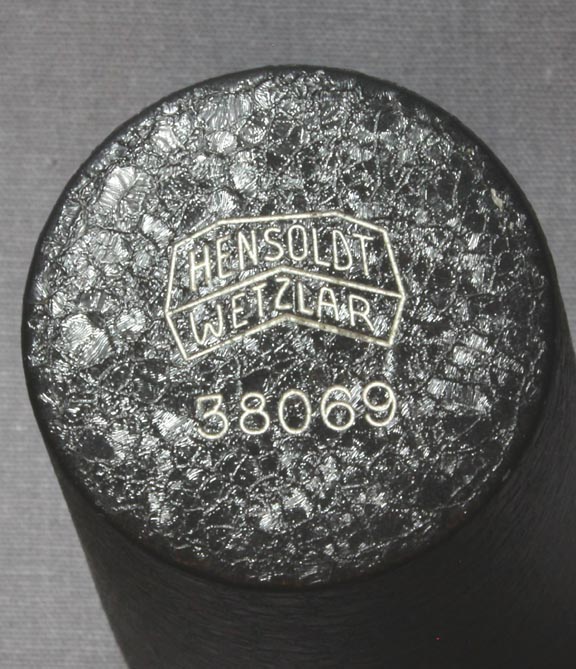 This later microscope has a 'crinkled' black and chrome finish. It has a round base of about 1 3/4 inches in diameter. The height with all the drawtubes extended is about 7 5/8 inches. Height of the cover is about 5 7/8 inches. The microscope is signed on the front:
This later microscope has a 'crinkled' black and chrome finish. It has a round base of about 1 3/4 inches in diameter. The height with all the drawtubes extended is about 7 5/8 inches. Height of the cover is about 5 7/8 inches. The microscope is signed on the front: Tamiabove the knurled focusing control and with the emblem with the words
HENSOLDT, WETZLARunder the control. On the back side, the microscope is signed with its serial number and below that, D.R.P. indicating it is patented in Germany. The top of the cover is signed with the newer insignia with the words:
HENSOLDT, WETZLARwith the serial number beneath the insignia. Note that this instrument has the newer insignia without the dots on each side of the word
WETZLARThe focusing control simple threads the optical tube through the support ring. The stage is made of glass with a fixed angled mirror in the removeable base. The black stage clips attach to the ring around the base. There are two draw tubes, each calibrated with magnifications. The upper draw is calibrated from 70 to 145 while the lower one is calibrated from 160 to 230. There is a single eyepiece and a single objective.
THE NEWER TAMI MODELS
 After the Tami model was improved, additional variants were added. These included both biological and metallurgical (surface inspection) models. Instead of the black finish, the optical tube was now made of an aluminum-color alloy. The example shown here has a black stage with stage clips, but the foot has a cutout so it can also be used as a surface inspection microsope. Note that this model has no substage mirror or condenser. It has no draw tube. Coarse focusing is by pulling the tube in or out and then locking it in place with a small knob in the back of the microscope. The approximate focus is indicated by fine blue lines for one power and red for the other; there are two pairs of lines, one for stage focusing and the other for surface focusing. Fine focus is via the knurled alloy knob below the eyepiece. These eyepieces, a 20X and a 40X had reticles for measurement, but only the 20X has one now, the other is worn off. Focusing on the reticle is provided by the knurling on black plastic-covered eyepiece. The extra eyepiece is stored in a cardboard container. The microscope is stored in its conical flat-topped metal case with the 20X eyepiece, and the tube lowered to touch the stage. The stage is easily removed via a screw accessible from the rear of the microscope. Once fully seated in the case, the sliding extension of the foot is pushed in with its two pins sliding into holes in the front of the case to secure the microscope in place. The cover and foot and upright support is a finely abraded flat gray finish, while the ring around the tube is a smooth gloss gray finish. It is engraved HENSOLDT WETZLAR in white lettters inside the trademark symbol. The optical tube bears the serial number of 14315. The cap of the carboard container for the spare eyepiece bears the same HENSHOLDT WETZLAR trademark. The sliding foot extension is labeled
After the Tami model was improved, additional variants were added. These included both biological and metallurgical (surface inspection) models. Instead of the black finish, the optical tube was now made of an aluminum-color alloy. The example shown here has a black stage with stage clips, but the foot has a cutout so it can also be used as a surface inspection microsope. Note that this model has no substage mirror or condenser. It has no draw tube. Coarse focusing is by pulling the tube in or out and then locking it in place with a small knob in the back of the microscope. The approximate focus is indicated by fine blue lines for one power and red for the other; there are two pairs of lines, one for stage focusing and the other for surface focusing. Fine focus is via the knurled alloy knob below the eyepiece. These eyepieces, a 20X and a 40X had reticles for measurement, but only the 20X has one now, the other is worn off. Focusing on the reticle is provided by the knurling on black plastic-covered eyepiece. The extra eyepiece is stored in a cardboard container. The microscope is stored in its conical flat-topped metal case with the 20X eyepiece, and the tube lowered to touch the stage. The stage is easily removed via a screw accessible from the rear of the microscope. Once fully seated in the case, the sliding extension of the foot is pushed in with its two pins sliding into holes in the front of the case to secure the microscope in place. The cover and foot and upright support is a finely abraded flat gray finish, while the ring around the tube is a smooth gloss gray finish. It is engraved HENSOLDT WETZLAR in white lettters inside the trademark symbol. The optical tube bears the serial number of 14315. The cap of the carboard container for the spare eyepiece bears the same HENSHOLDT WETZLAR trademark. The sliding foot extension is labeled Made in Germany. This is a well-made instrument with a nice inclination joint, in fine cosmetic,mechanical, and optical condition.
New Tamimodel made from the 1950s to 1960s. Some examples of these variations are shown below:

THE METAMI MODEL
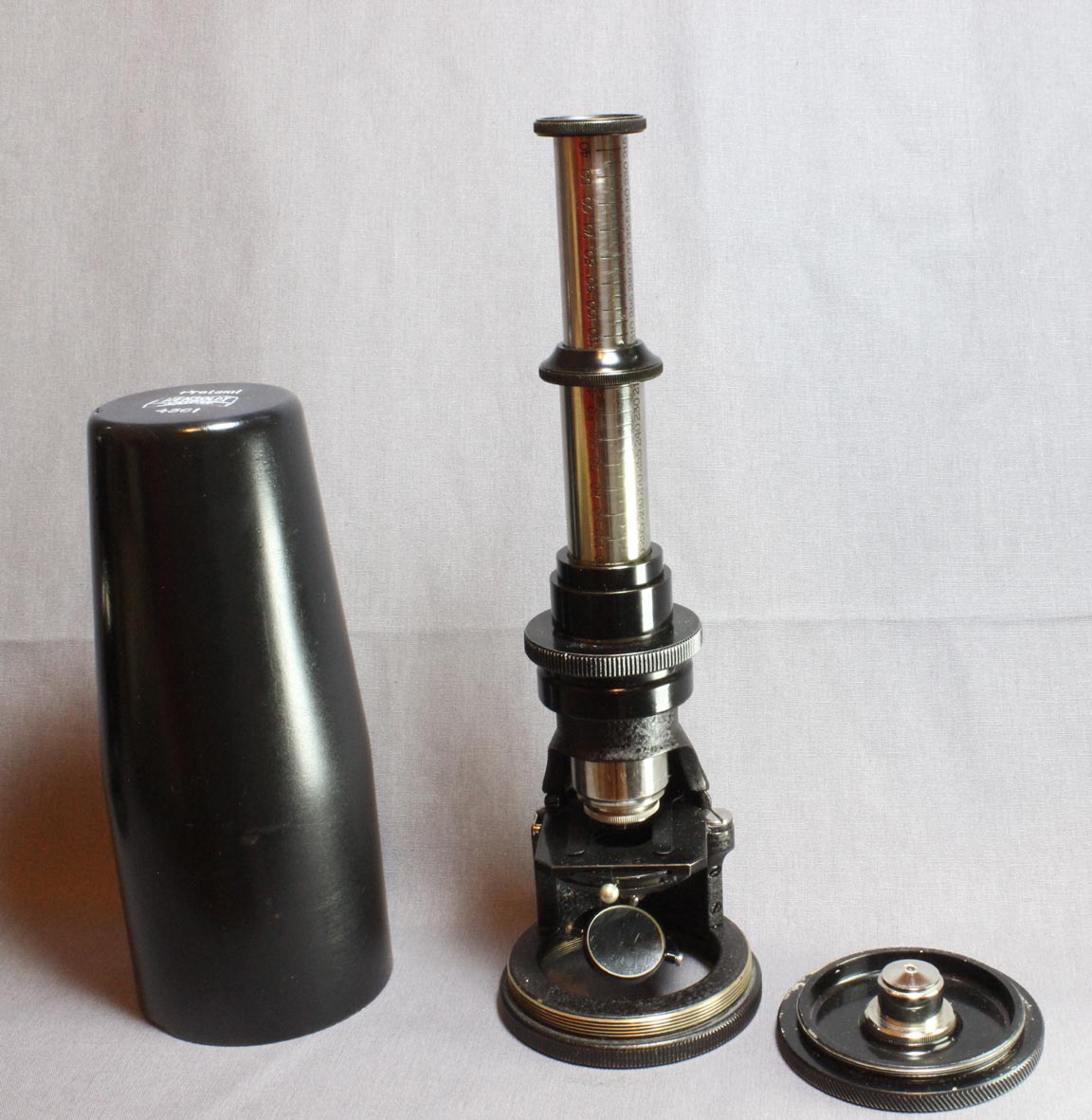
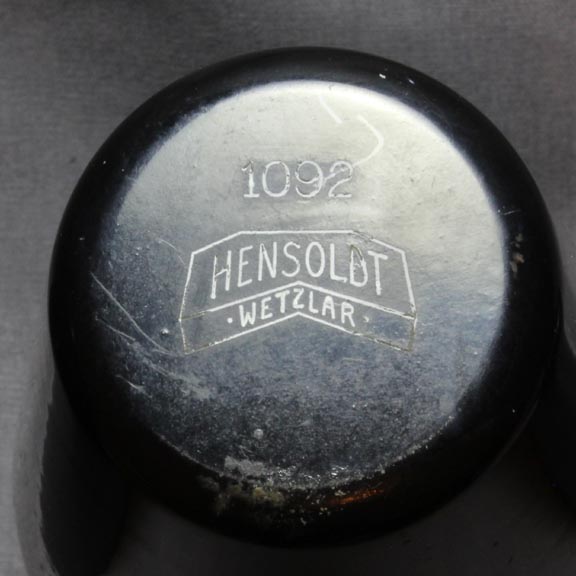 This microscope has a smooth semigloss black and chrome or nickel finish. It has a round base of about 2 5/8 inches in diameter. The height with both of the drawtubes extended is about 9 inches. Each draw tube is calibrated. The upper draw tube is calibrated from 40 to 115 and 215 to 315. The lower draw tube is calibrated from 40 to 110 and also from 215 to 310. Apparently one needed to add the magnification from each to arrive at the total. Height of the cover is about 5 3/4 inches. It is signed
This microscope has a smooth semigloss black and chrome or nickel finish. It has a round base of about 2 5/8 inches in diameter. The height with both of the drawtubes extended is about 9 inches. Each draw tube is calibrated. The upper draw tube is calibrated from 40 to 115 and 215 to 315. The lower draw tube is calibrated from 40 to 110 and also from 215 to 310. Apparently one needed to add the magnification from each to arrive at the total. Height of the cover is about 5 3/4 inches. It is signed HENSOLDT, WETZLARin the emblem on the back, and
D.R.P.below that; lower down it is signed
Metami, Vergr. 25-600. Vergr. is an abbreviation for the German word for magnification. Just below the focusing control is a sticker by a retailer, labelled
PALO COMPANY, NEW YORK. The D.R.P., which stands for Deutsches Reichspatent, is the German term for patent. The cover is signed with the serial number
1092above the insignia signed
HENSOLDT, WETZLAR.
THE PROTAMI MODEL
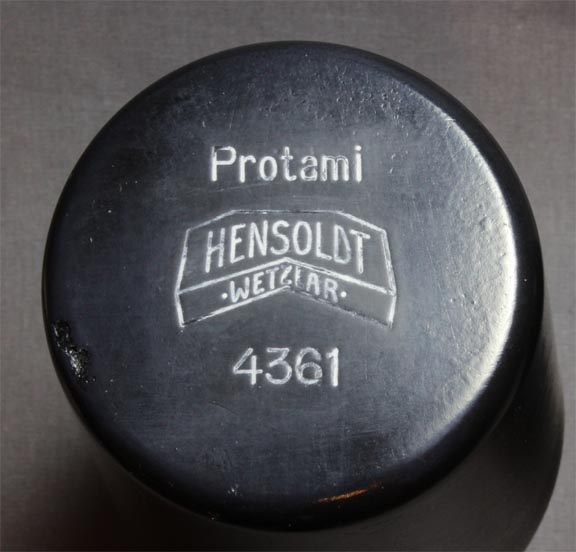
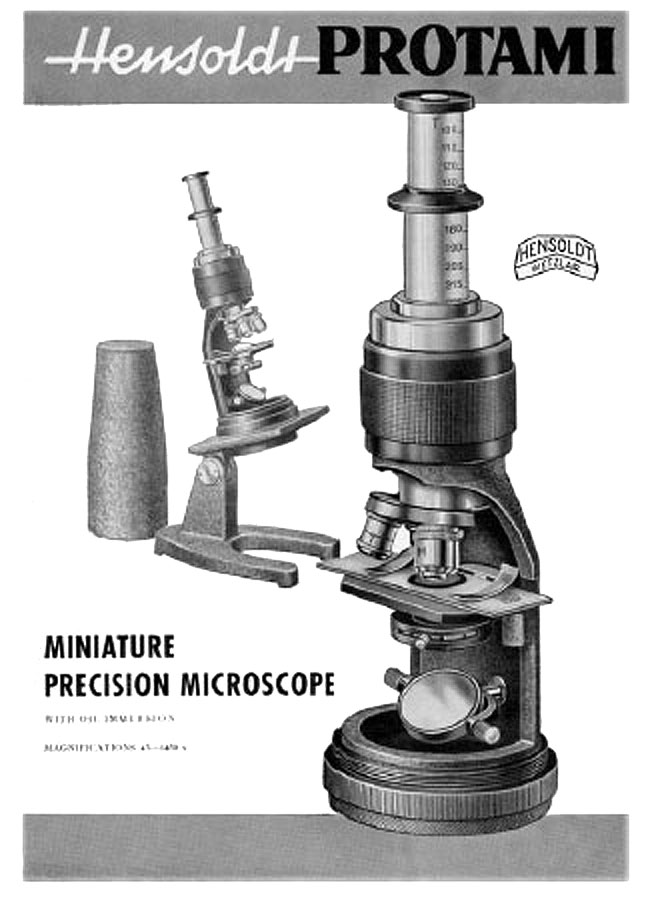 The cover of the Protami microscope has a smooth semigloss black finish. The microscope itself has a
The cover of the Protami microscope has a smooth semigloss black finish. The microscope itself has a crinkle blackfinish except for the stage and focusing knob which are a semigloss or flat black and some parts including the objectives have a nickel finish. It has a round base of about 1 3/4 inches in diameter. The height with all the drawtubes extended is about 7 5/8 inches. Height of the cover is about 6 1/4 inches. The back of the instrument is signed:
HENSOLDT, .WETZLAR.in the insignia. It is also signed
Protami, D.R.Pand
Vergr. 40-1200. The top of the cover is signed
Protamiabove the insignia signed
HENSOLDT, .WETZLAR.. Below the insignia is the serial number
4361
1/12, n.a. 1.3.The microscope could also be ordered with a 1/10 objective instead of a 1/12. The two draw tubes are each calibrated with sets of magnifications. The top draw tube is calibrated from 90 to 160 and also from 340 to 545. The bottom draw tube has three sets of calibration markings, one for each objective; 170 to 250, 565 to 760, and 880 to 1200. The stage can be turned aside just like the Metami, but instead of just an iris, it has a full substage condenser above the iris. The stage clips are made of a nickel finished metal. Like the Metami it has an articiated substage mirror. Unlike the Metami, there is no need for storage of another objective; their is a hole in the base. Just like the Tami, the Protami had an inclination attachment available for an extra charge. Just like the Metami, the focus control moves the optical tube without rotating it. Unlike the Tami and the Metami, the Protami has an oval cutout in its back. Later versions of the Protami cover had a crinkle finish similar to the microscope. Another feature was a small canister similar to a standard can for holding objectives which attached to the bottom of the stage. It housed a small vial of immersion oil. The top of the canister had a dovetail that slid into a dovetail slot on the bottom of the stage. My example has the dovetail slot under the stage but the can is missing.